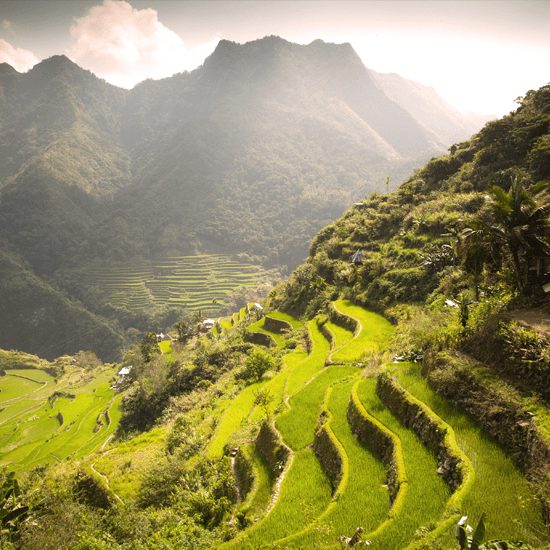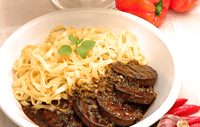
At the crossroads between China, Thailand, Vietnam, Indonesia, Malaysia and India, with heavy influences from Spain and the United States, and consisting of 135 distinct ethno-linguistic tribes within the Philippines, it's no surprise that Filipino cuisine is so varied and rich.
Most Filipino dishes consist of a combination of sweet, sour and salty, with dishes from the Cordilleras region and those enjoyed by Muslim Filipinos adding in a good deal of spice. Here are 9 of the ones we love most:
- Adobo: Although it's originally Mexican, Filipinos have made this mouthwateringly delicious dish their own. Adobo consists of chicken, pork, lamb or seafood cooked in vinegar, salt, garlic, pepper, soy sauce and spices, and thanks to its preparation it can be stored for days without spoiling.
- Tinapa: Usually blackfin scad or milkfish that's preserved in brine and then smoked, tinapa is eaten for breakfast, lunch and dinner, usually with a garlic and vinegar dipping sauce.
- Lechon: A pig, spit-roasted over coals until its skin becomes crisp and golden brown, this delicacy is served with lechon kawali – or liver sauce – made from onions, garlic, breadcrumbs and liver spread.
- Bulalo: A popular hot beef broth native to the Southern Luzon region of the country, bulalo is made from cooking beef shanks and includes rich bone marrow.
- Arroz Caldo: Literally “rice soup", this soothing street food consists of a thick chicken rice porridge, cooked with ginger and garnished with egg, garlic and onions.
- Balut: Not for the faint of heart, balut is a popular Filipino dish consisting of a 17-day-old duck embryo floating in a mixture of hot sauce and vinegar.
- Suman at manga: This delectable sticky rice snack is steamed in banana or coconut leaves and includes sweet ripe mango.
- Pastillas de leche: Another sweet dessert, this confection consists of thickened milk and sugar – nomnomnom.
- Merienda: Not really a specific dish, merienda is essentially a morning or early evening snack that includes rice and a cool or hot drink. It can include bread, pastries, noodles or even balut.
Have you visited the Philippines or had an opportunity to try Filipino food? Tell us what you love most in the Shop Talk blog community forum.

Did you know: What’s with SPAM?
It’s no secret – Filipinos love SPAM, the American cooked canned meat. Introduced to it during World War II, a fast food chain in the country offers a menu based entirely on the processed meat – including SPAM burgers, SPAM spaghetti, SPAM poppers and more. (Source)

Beautifull Pictures
Vivre en santé et respirer dans un paysage magnifique a regardé
I’ve never tried Filipino food but I would love to! Well, except maybe for balut!
Not at all for me
This is an absolute wonderful article the dishes look and sound delicious !
I havent been o the Philippines yet but i am travelling there in September the food does sound interesting so looking forward to trying iit out and yes they do love there spam lol
I am proud of my filipino heritage and have been loving our food from adobo to balut!
As an American/Filipino born and raised in Vigan,Ilocos Sur and Paracale, Cam.Sur and Mànila disappointed you don’t include pancit. That is more popular than balut which I have never eaten. As for Spam ,,,once the war was over I never ate it again.it was great when the soldiers came. Here in Langley, BC Canada when I cook Filipino it’s adobo and lumpia and pancit. Even though I am 90 years old I haven’t forgotten.
The picture shows mountains with rice terraces. The Philippines is heavily populated. With this picture, one would think the Philippines has many wide open spaces.
I come from the Philippines and I love our food over there. Filipinos love rice. We love eating almost any main dish with rice.
Excellent write-up. Thank you!!!!
As my sister in law and also a couple of friends is Filipino I have eaten a few dishes I prefer the fish dishes although not a fan of Squid my favourite is the Pastilles De Leche which is similar to a President Choice desert I have eaten
My wife is Filipina and I have made one trip to the Philippines. I agree that few countries share the variety of influences in their food that the Philippines does. Those unfamiliar with Filipinos and their food might find it useful to know that many dishes are regional. Others such as adobo are found everywhere. Snacking is huge! Glad to see merienda mentioned! While Spam is singled out in this spotlight for its prevalence in the Philippines, it it also a big seller in the Marshall Islands and Hawaii (and perhaps other US-influenced areas of the Pacific). It might be noted that canned corned beef, locally known as “Carne norte” competes with Spam for popularity, with the South American variety showing up more often than the Australian and New Zealand brands.
It’s nice to see Filipino food in the spotlight for a change. For some reason, it has never hit the mainstream to the same degree as other Asian cuisines. I would add a few dishes to your list:
1) Lumpia (spring roll – typically deep-fried – with a meat or veggie filling);
2) Pancit (there are many varieties of this noodle dish that resembles chow mein or lo mein);
3) Asado (Spanish-influenced, tomato-based pork stew);
4) Kare Kare (stew with pork, oxtail, and/or organ meats in a peanut-based sauce);
5) Dinuguan (braised organ meats in a blood pudding-based sauce – delicious, but not for the squeamish);
6) Sinigang (a hearty soup of seafood, meat, and vegetables with a tamarind-flavored broth)
7) Halo Halo (a shaved ice dessert parfait with evaporated milk and various treats)
8) Ube desserts (using a naturally bright purple yam called ube – in sweet buns, sticky puddings, etc)
Filipino food is like Cantonese food with a Spanish and Polynesian influence, generally not spicy and never very formal. Because of regional availability, you won’t find much dairy, beef, or wheat in the dishes – there is more focus on pork, chicken, seafood, rice, and coconut. Meals are usually served family-style with steamed or fried rice. Enjoy!
Lechon kawali is another popular Filipino dish — it is pork belly cooked tender then deep fried until the whole belly is a crispy golden brown — and a smaller option to roasting a whole pig for lechon. Lechon sauce or “sarsa ng lechon” is a special sauce made from pork liver pate cooked with vinegar, onions, garlic, and pepper, reduced until thick or thickened with bread crumbs and slightly sweetened with brown sugar.
I highly recommend to try Halo-halo, it’s very popular during summer time. I suggest to eat some delicacies like sisig, kare-kare, street food like isaw, one day old chicken, betamax, goto,etc. You can explore the beutiful sceneries of the Philippines like in Palawan, Ilocos region, Baguip, Pagudpod, Bataan,Pampanga, Boracay, Bacolod, Surigao,etc.
If you lobe tattos, fins Whang-od Oggay, also known as Maria Oggay, is a Filipina tattoo artist from Buscalan, Tinglayan, Kalinga, Philippines. She is often described as the “last” and oldest mambabatok and is part of the Butbut people of the larger Kalinga ethnic group.
im dating a pinay and trust me the food is good but it needs “heat” and i have had the honor of going to a traditional philippine birthday where the table was laid out with banana leaves and the food served on top and we ate with our fingers it was fantastic.
Good recipes.
Actually we bought 2 cans of spam last month. Fried some of it and then put it in my egg dish it was great.
i’ve never heard of it,but sounds good.i might try it.
Filipinos don’t like SPAM as much as they do CORNED BEEF!
Forget about SPAM. It’s CORNED BEEF that Filipinos really love.
Good article but missing links to recipes. Winnipeg has not just one but two outlets of Jolibee restaurants. The only ‘ones’ in Canada with a population of close to 70,000 Filipinos. Even Justin Trudeau likes to visit them when in Manilla.
Yes, Filipino food-all delicious mouth watering food!!! I love it!
They have good tastes. like spam too!
At the crossroads? What crossroads? Did you look at a map before producing this article? No wonder the author is anonymous since they don’t know what they’re talking about. Lazy internet writing. But, hey, we needed an intro sentence so let’s just say anything. Nobody will check…
Cultural, not geographical, crossroads. Hence the mixture of different influences.
I look for emails from Shoppers Voice as I know the articles are informative, photographs displayed are creative and the Shoppers Voice is always enjoyed.
Filipinos have healthy taste buds that’s why when we’re cooking and we’re sharing it to other nationalities they are, most often than not, amaze at the taste. We just don’t settle for something simple like blanching veggies or cook without any sahog (ingredients). In this blog, we should have included pansit and lumpia which are also popular among Filipinos specially on handaan or celebrations whether it be birthday, Christmas etc.
When we would go to Florida on vacation we would always have fried spam and eggs for breakfast and we loved it.
Yes I have been to the Philippines. I went to the Island of Cebu where my wife is from.
The one thing that I have noticed about Filipino food is that it can very in flavor depending on which island in the Philippines the cook comes from.
I feel that you have presented a really good conversation about Filipino food in a brief article.
Never been
Food sound good there for the most part
wow! looks beautiful
I am a Filipino and I’ved tried all sorts of Filipino dishes specially Adobo. Adobo has different version, depending on the provinces in the Philippines. Others are making a typical Adobo with just pork/chicken, liver with soy sauce, vinegar, garlic and bay leaf. Others does not add soy sauce, instead they are adding patis (fish sauce) and we called that Adobong puti. While other people add beer on their Adobo recipes. This dish is an all-time favorite of all Filipinos and even foreigners. Tinapa is best served with fried rice. Other people shred it and used it for pancit palabok. Lechon is another all-time favorite. Most festivities served Lechon with an apple on porks mouth. It is indeed a very good dish. But you have to watch out for your blood pressure when you eat it! Bulalo is a hot beef soup with bone marrow and vegetable and corn. It is best served with plain rice with fish sauce and calamansi to add extra flavor on the broth. Arroz caldo is a rice porridge, typically it is just a merienda or breakfast for most Filipinos, but it is usually served for a child or even an adult who is sick and doesn’t want to eat anything. Balut is a street food served with chilli vinegar and salt. Mostly they eat it with beer or any alcoholic drink. Suman at mangga its another snack or dessert. It is a sticky rice wrapped in coconut leaves with a ripe mango, It is best served with hot chocolate. Pastillas de leche is also a dessert made with condensed milk rolled in sugar. Other people add some chocolate powder on it or nuts to have a twist taste on it.